|
|
|
| My Favourite Planet > English >
People > Medusa > part 5 |
 |
back |
Medusa – part 5 |
 |
Page 5 of 8 |
 |
|
| |
Gorgons on sarchophagi
and other Roman period funerary monuments |
| |
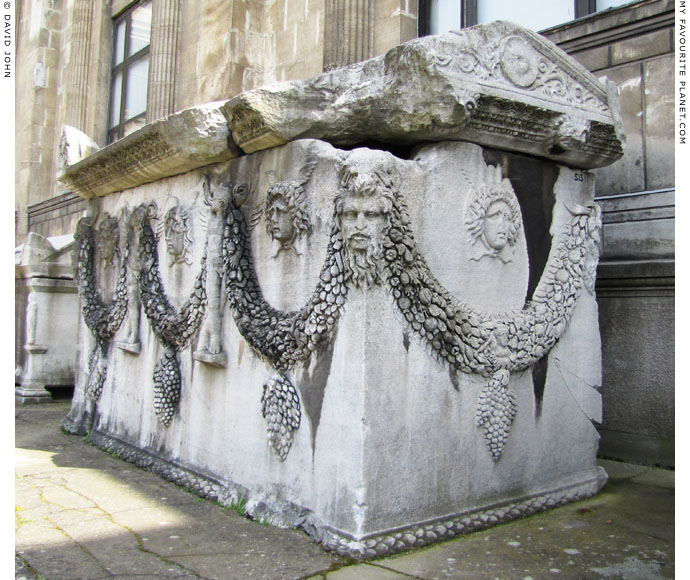
A large marble sarcophagus decorated all around with reliefs of Gorgoneions and garlands
supported by Erotes (figures of Eros), and heads of Pan at each corner. Part of the lid and
body of the sarcophagus appear to have been hacked away, perhaps by grave robbers.
See a photo of one of the heads of Pan on the Pan page.
From Byzantium (Istanbul). Roman Imperial period, 2nd century AD.
Height 243 cm, width 342 cm, depth 170.5 cm.
In the courtyard of the Istanbul Archaeological Museum. Inv. No. 513.
Acquired by the museum in 1880.
See also a relief of Perseus and Medusa on the
"Golgoi sarcophagus" from Cyprus in Medusa part 1. |
| |
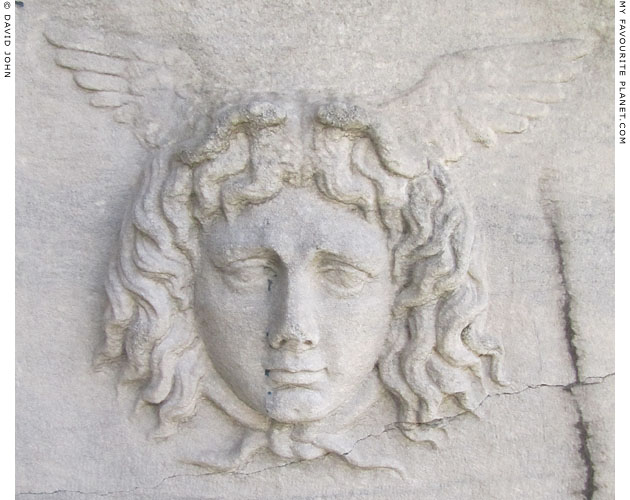
A winged head of Medusa (Gorgoneion) on the left side of the sarcophagus above. |
| |
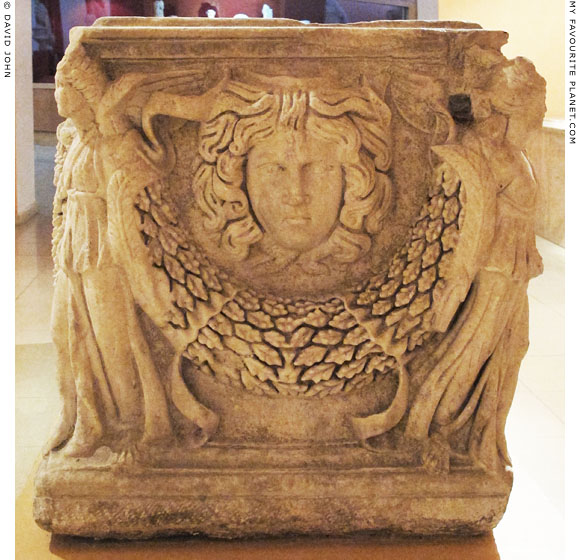
A Gorgoneion on the end of a marble sarchophagus from Sardis. Roman Period.
Izmir Museum of History and Art. |
| |
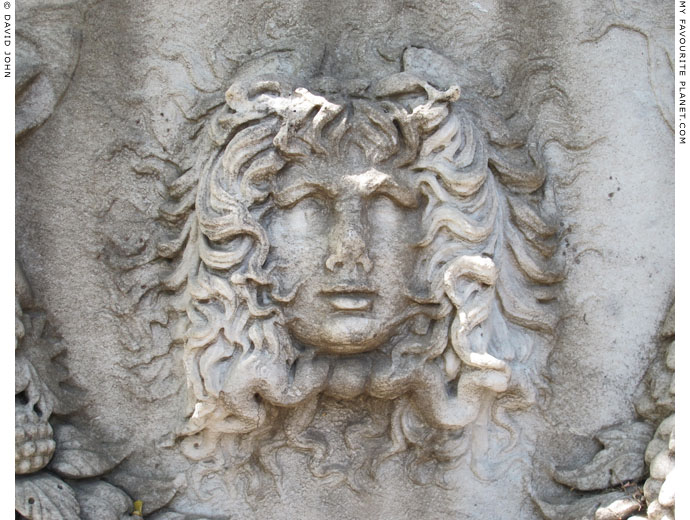
A winged Gorgoneion with wild hair on a marble sarchophagus from
Aydin (Germencik), western Turkey. 2nd century AD, Roman Period.
Izmir Archaeological Museum. Inv. No. 3557. |
| |
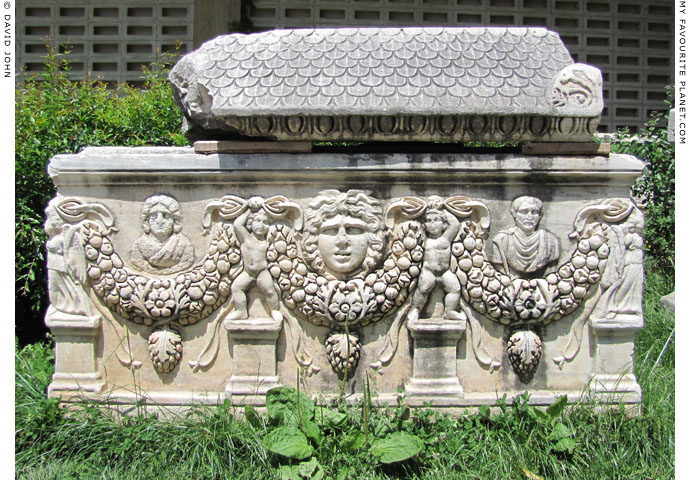
A relief of a Gorgoneion of the "beautiful type" on the front
of a marble sarchophagus from Ephesus. Roman Period.
Outside the Ephesus Archaeological Museum, Selçuk, Turkey. Inv. No. 4/4/74.
|
The Gorgoneion is in the centre, flanked by busts of a mature woman (left) and bearded man. Below each figure is a garland (or swag) of fruit and flowers, hung with a bunch of grapes and a vine leaf, and fastened to the next garland with ribbons tied with bows. The garlands are held up by two erotes (cupids), standing on pedestals either side of the Gorgoneion, and at each of the four corners by a winged Nike (Victoria) on a pedestal. The left end of the tomb is also decorated with a not-so-attractive, masculine-looking Gorgoneion above a garland (see photo below). The relief head (or emblem) on the right side is too worn to be identified. The rear may also be decorated but is obscured by plants growing on the fence behind.
Roman period, 140-180 AD. Found in 1954 at the foot of the Astyagou Pagos, west of the Lysimachian city wall of Ephesus. Dimensions (without lid):
Height 104 cm, length 229 cm, depth 108 cm. |
|
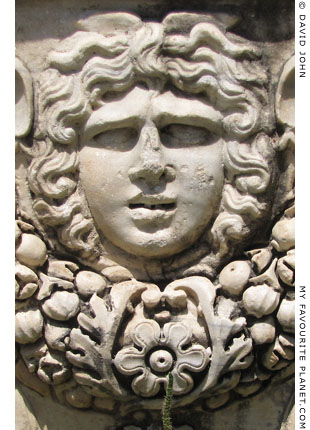
A "beautiful type" Gorgon head. |
|
| |
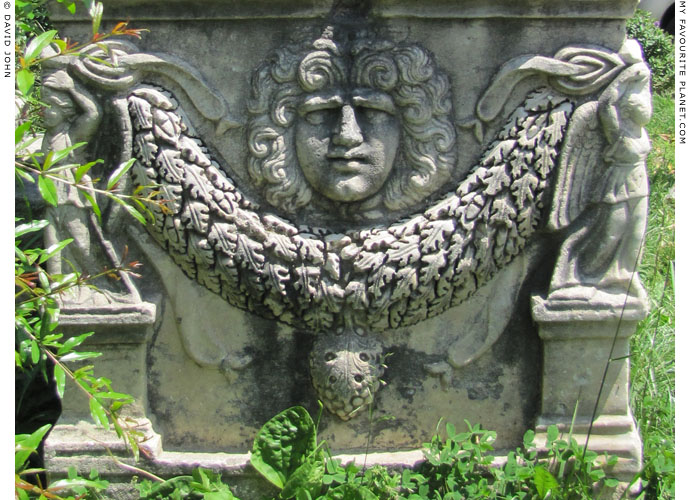
The masculine-looking Gorgoneion on the left side of the sarchophagus from Ephesus above. |
| |
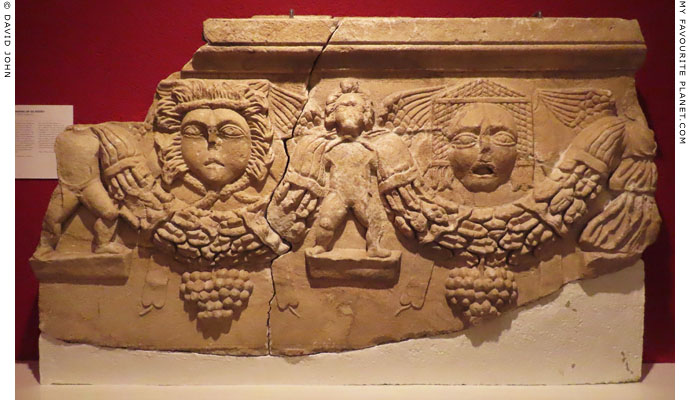
Part of the front of a marble sarcophagus with a relief of a Gorgoneion (left) and
a tragedy mask, above garlands hung with bunches of grapes. The garlands are
supported on the left and in the centre by winged Erotes (Cupids), and on the
right by a winged Nike. The relief is thought to symbolize victory over death.
Roman period, end of the 3rd century AD. From Anatolia (Asia Minor).
Allard Pierson Museum, Amsterdam. Inv. No. APM 10.194. |
| |
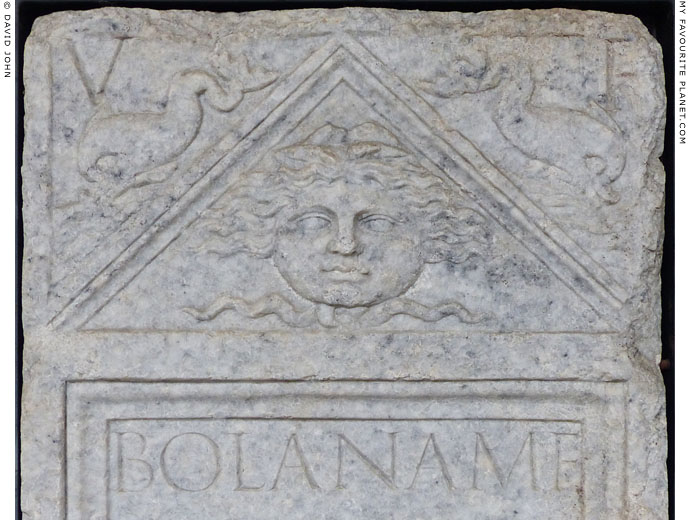
The top of an inscribed funerary stele with a relief of a Gorgoneion
and dolphins, from the Roman city Mediolanum (Milan).
Musso marble. Late 1st - early 2nd century AD.
The inscription states that the stele was commissioned by
a woman, Bolana Secunda, and includes details of her will.
Civic Archaeological Museum, Milan. Inv. No. A 0.9.6600. |
| |
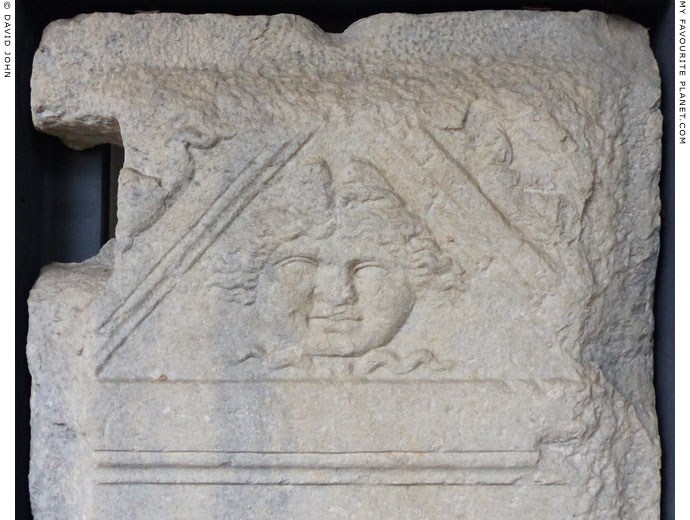
The top of the inscribed funerary stele of the shoemaker Gaius Atilius Iustus, with
a relief of a Gorgoneion and dolphins from the Roman city Mediolanum (Milan).
Musso marble. 2nd century AD. Found in the 16th century in Porto Nuovo, Milan.
Civic Archaeological Museum, Milan. Inv. No. A 0.9.6620. |
| |
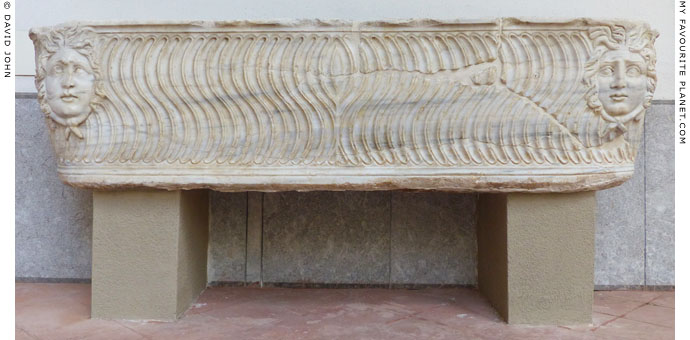
Lenos (grape treading tank) shaped marble sarcophagus with
a strigillated relief pattern and Gorgon heads at either end.
From Panormou (ancient Palermo), Sicily. 3rd century AD.
Antonino Salinas Regional Archaeological Museum, Palermo, Sicily. |
| |
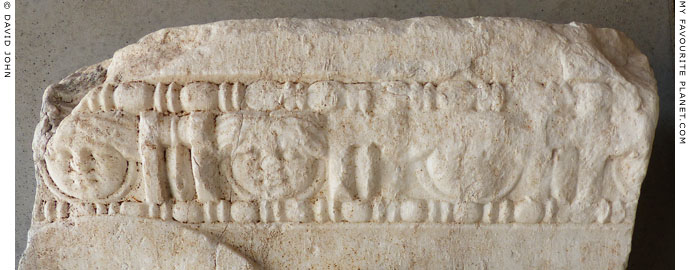
Part of a frieze in the form of triglyphs and metopes, in each of which is a relief of
a Gorgoneion. Detail of a fragment of an Attic marble sarcophagus. Below the frieze
is part of a relief depicting Priam ransoming the body of Hektor (see Homer part 2).
Second half the 3rd century AD. Provenance unknown.
Thebes Archaeological Museum. |
| |
Photos on the Medusa pages were taken
during visits to the following museums:
Germany
Berlin, Altes Museum
Berlin, Bode Museum
Berlin, Neues Museum
Dresden, Albertinum, Skulpturensammlung
Dresden, Semperbau, Abgusssammlung
Dresden, Staatliche Kunstsammlungen, Münzkabinett
Hamburg, Museum für Kunst und Gewerbe
Speyer, Historisches Museum der Pfalz
Greece
Abdera Archaeological Museum, Thrace
Athens, Acropolis Museum
Athens, Epigraphical Museum
Athens, Kerameikos Archaeological Museum
Athens, National Archaeological Museum
Athens, Numismatic Museum
Corfu Archaeological Museum
Corfu, archaeological site of the Temple of Artemis
Corfu, Museum of Mon Repos
Corinth Archaeological Museum
Delos Archaeological Museum
Delphi Archaeological Museum
Dion Archaeological Museum, Macedonia
Eleusis Archaeological Museum and site, Attica
Eretria Archaeological Museum, Euboea
Isthmia Archaeological Museum
Kavala Archaeological Museum, Macedonia
Komotini Archaeological Museum, Thrace
Kos Archaeological Museum, Dodecanese
Marathon Archaeological Museum, Attica
Mycenae Archaeological Site and Museum
Mykonos, Aegean Maritime Museum
Mykonos Archaeological Museum
Nafplion Archaeological Museum, Peloponnese
Olympia Archaeological Museum, Peloponnese
Olympia, Museum of the History of the Olympic Games in Antiquity
Patras Archaeological Museum, Peloponnese
Philippi Archaeological Museum
Piraeus Archaeological Museum, Attica
Polygyros Archaeological Museum
Pyrgos Archaeological Museum, Elis
Rhodes Archaeological Museum, Dodecanese
Rhodes, Palace of the Grand Master
Thasos Archaeological Museum, Macedonia
Thebes Archaeological Museum, Boeotia
Thessaloniki Archaeological Museum, Macedonia
Veria Archaeological Museum, Macedonia
Italy
Milan, Civic Archaeological Museum
Naples, National Archaeological Museum
Ostia Archaeological Museum
Paestum, National Archaeological Museum, Campania
Rome, Capitoline Museums, Palazzo dei Conservatori
Rome, National Etruscan Museum, Villa Giulia
Rome, National Museum of Rome, Baths of Diocletian
Rome, National Museum of Rome, Palazzo Massimo
Rome, Villa Farnesina
Italy - Sicily
Agrigento Regional Archaeological Museum
Castelvetrano, Museo Civico
Catania, Museo Civico, Castello Ursino
Gela Regional Archaeological Museum
Palermo, Antonino Salinas Archaeological Museum
Syracuse, Paolo Orsi Regional Archaeological Museum
Netherlands
Amsterdam, Allard Pierson Museum
Leiden, Rijksmuseum van Oudheden
Turkey
Bergama (Pergamon) Archaeological Museum
Didyma archaeological site
Ephesus Archaeological Museum, Selçuk
Ephesus archaeological site
Istanbul Archaeological Museums
Istanbul, Basilica Cistern
Izmir Archaeological Museum
Izmir Museum of History and Art
Manisa Archaeological Museum
United Kingdom
London, British Museum
Oxford, Ashmolean Museum
Many thanks to the staff of these museums,
especially at Dion, Gela, Manisa and Veria. |
|
| Photos and articles © David John, except where otherwise specified. |
 |
Visit the My Favourite Planet Group on Facebook.
Join the group, write a message or comment,
post photos and videos, start a discussion... |
|
|
| |
|
|
| |
| |
 |
| |
 |
| |
 |
| |
 |
| |
 |
| |
 |
| |
George Alvanos
rooms in
Kavala's historic Panagia District
Anthemiou 35,
Kavala, Greece
kavalarooms.gr
|
| |
Olive Garden Restaurant
Kastellorizo,
Greece
+30 22460 49 109
kastellorizo.de
|
| |
Papoutsis
Travel Agency
Kastellorizo,
Greece
+30 22460 49 286
greeklodgings.gr
|
| |
|